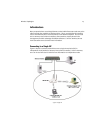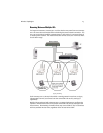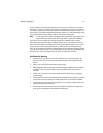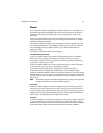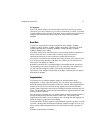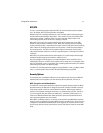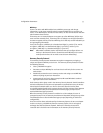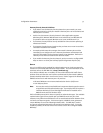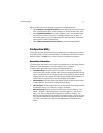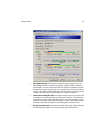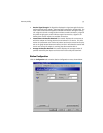Configuration Parameters 32
RTS/CTS
The 802.11a standard supports optional RTS/CTS communication based on packet
size. By default, RTS/CTS communication is disabled.
Without RTS/CTS, a sending radio listens to see if another radio is already using the
medium before transmitting a data packet. If the medium is free, the sending radio
transmits its packets. However, there is no guarantee that another radio is not
transmitting a packet at the same time, causing a collision.
When RTS/CTS occurs, the sending radio first transmits a Request to Send (RTS)
packet to confirm that the medium is clear. When the receiving radio successfully
receives the RTS packet, it transmits back a Clear to Send (CTS) packet to the sending
radio. When the sending radio receives the CTS packet, it sends the data packet to
the receiving radio. The RTS and CTS packets contain a reservation time to notify
other radios that the medium is in use for a specified period. This helps to minimize
collisions.
While RTS/CTS adds overhead to the radio network, it is particularly useful for large
packets that take longer to resend after a collision occurs.
You may configure a Harmony 802.11a network adapter to never use RTS/CTS (i.e.,
disable RTS/CTS) or to use RTS/CTS for packets over a certain size. For example, if the
RTS/CTS Threshold is set to 1000 Bytes, then a sending radio will use RTS/CTS before
transmitting any packet 1000 Bytes or larger.
The RTS/CTS Threshold parameter supports a range between 1 and 2345 Bytes. When
set to 1, a sending radio will use RTS/CTS before transmitting any packet.
Security Options
The Harmony 802.11a adapters offer four security options: No Security, Use WEP for
Authentication and Encryption, Use the Harmony Security Protocol, and 802.1x.
WEP Encryption and Authentication
The IEEE 802.11a standard specifies an optional encryption feature, known as Wired
Equivalent Privacy or WEP, that is designed to provide a wireless LAN with a security
level equal to what is found on a wired Ethernet network. WEP encrypts the data
portion of each packet exchanged on the 802.11a network using a 64-bit, 128-bit, or
152-bit encryption key (also known as a WEP Key). In addition, Harmony 802.11a
devices use WEP with Shared Key Authentication to prevent unauthorized devices
from associating with an 802.11a network.
When WEP is enabled, two 802.11a devices must have the same WEP Keys and both
devices must be configured to support WEP in order to communicate. If one device is
configured to use WEP for Authentication and Encryption but a second device is not,
then the two devices will not communicate, even if both devices have the same WEP
Keys.



